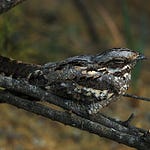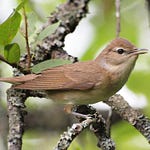Here’s one with which to amaze friends and casual bystanders.
At first it’s a buoyant chatter, coming from some distance away, at around tree top or roof height.
Gradually it gets louder: quick-fire resonant ‘chips’, like stones hitting ice on a pond.
Then, with luck, they appear - chunky finches with shortish tails, chip-chip-chipping all the way as they go.
Crossbills can be found year round in their preferred habitat of conifereous woodland. They spend most of their lives high up in the trees, clambering around at impressive angles and performing their superpower: prising the seeds from cones.
The trick is in the crossed tip to the beak, a rare assymetry in the bird world.
The twisted overlap in the mandibles allows a crossbill to lever apart the woody scales of cones that most other species find impenetrable.
This advantage gives them almost exclusive access to what can be an abundant source of food.
In years of plentiful supply it means that crossbills can breed over the course of a long season. Nesting can begin as early as December, and they may raise further broods all the way till June.
The big numbers of young crossbills that result get through a great many seeds. When these bumper populations deplete the local food supply they become nomadic and spread far and wide.
It’s in these years that we might encounter them in unlikely-seeming spots, away from their regular haunts.
They can turn up in small plantations and in thinly-scattered pines on heathland. And sometimes they can cross paths with us as they travel the distances between.
So, you might hear a flock freshly arrived from continental Europe on the English coast, or as they bounce their way inland over open coutryside - perhaps even as they cross completely built up areas.
This is one such year, with crossbills being heard and seen across the south of England. In recent weeks they’ve been in our local woods, and over the middle of the town where we live.
Without fail it’s that chip-chip call that gives them away.
The crossbill, known more specifically as the Common Crossbill (in Europe) or Red Crossbill (in North America) has a wide distribution in the northern hemisphere, correlating with regions of coniferous woodland.
The film below from Cornell shows just how the closely-related White-winged (or Two-barred) Crossbill uses the cross-tipped beak to feed.
This is the 27th instalment in 2025’s cycle of Shriek of the Week. From July to December, posts are less than weekly, reflecting a quieter season for birdsong in the UK.
You can catch up with Robin - which includes details of how this works - as well as Wren, Song Thrush, Blackbird, Great Tit, Dunnock, Chaffinch, Goldcrest, Nuthatch, Chiffchaff, Skylark, Great Spotted Woodpecker, Blackcap, Starling, Willow Warbler, Nightingale, Whitethroat, Swift, Redstart, Greenfinch, Turtle Dove, Spotted Flycatcher, Firecrest, Garden Warbler, Nightjar and Coal Tit.
For those who can, subscribing to the paid tier of Shriek of the Week supports me to write more and keep this all going.
It also gets you access to the full A-Z archive of Shriek of the Week AND our livestream-hopping Early Bird Club call - the next is 8am BST (GMT +1) on Saturday 2 August.
Thanks to all continuing subscribers for your support.
Spruces and pines: a confession
I.
I’m nearly 50 years old, and I’ve just realised that I’ve never really understood the difference between a spruce and a pine.
How many times have I mislabelled one for the other? In public?
Embarrassing!
It reminds me how partial the focus of my interests can be.
I’m well attuned to the differences between a crossbill and, say, a greenfinch. If I heard someone confusing them I’d find it hard not to offer a correction, whether my expertise were invited or not (another shudder there: mild self-loathing!).
But faced with most kinds of plant, or bee, or slime mould and I’m on much humbler ground.
II.
The role I took on in January, with Sussex Wildlife Trust, is exposing to me to a broad array of subject matter. Most days I learn a little more outside my avian confort zone.
We receive questions all the time - what's this bug in my pond? Must I worry about the behaviour of that hedgehog? Should my neighbour be trimming their bush this month?
Some I have answers for, and many I do not. Across the Trust there are lots of people who know about such things, and collectively we can often find an answer.
Yet increasingly I’m struck by how much there is to know, and how much remains quite mysterious to me, and sometimes to everyone.
III.
Another confession: until recently I was unaware of famed Sussex-based naturalist Len Howard.
In the mid-20th century Len Howard shared her home in Ditchling near Brighton with many wild birds (blue tits roosting in the curtains, etc). She observed, recorded and interpreted their behaviours in extraordinary detail, over many years.
Recently I was asked to write a snippet for the Trust’s magazine, about her second book, Living with Birds.
The book includes an extended account of her relationship with a great tit she named Star, who learned to count to the number eight in response to rewards taken from the author’s hand.
Seeing the world through Howard’s eyes, you can’t help but appreciate birds as individuals (the very title of her first book), each with their own unique stories and characters.
I think, at times, many of us understand and feel this to be true, of all beings.
Yet it can be inconvenient to abide with that truth.
IV.
Someone on Bluesky was asking for an ID of a creature they’d met in the Swiss Alps. This was posted in response.
Yes, it’s a marmot. But just as importantly, it’s Jeff.
Or Alan.
Or Steve.
V.
And still, I’m glad to take the opportunity to put in writing something I now know about a general grouping of non-birds.
spruces and pines are both kinds of conifer, but distinct from one another.
spruce needles are evenly attached to the branch
whereas pine needles jut out in bunches
both spruces and pines produce cones with seeds in, upon which birds such as crossbills feed
but a cone from a spruce is not a pine cone
and if I ever say such a thing again, may a well-fed crossbill drop one right on my head
I didn’t even get started on firs. Fortunately this person did.
Media credits
Crossbill image by Ron Knight from Seaford, East Sussex, United Kingdom, CC BY 2.0, via Wikimedia Commons














Share this post